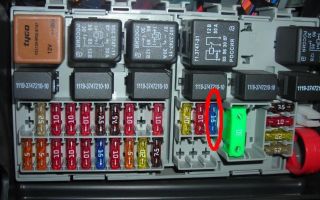Road sign "Pedestrian crossing"
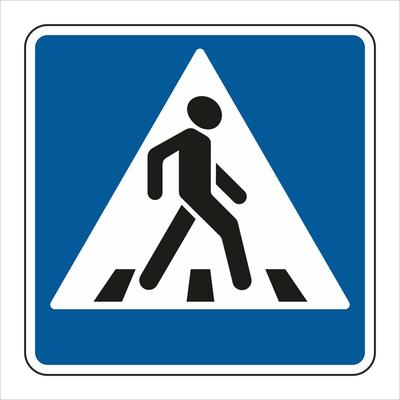
To regulate traffic on the roads, signs are installed not only for drivers, but also for pedestrians. Thus, the most famous and widespread sign for crossing a road is a “pedestrian crossing.”
People should only cross the road in areas designated for pedestrian crossings. Drivers, seeing a pedestrian in this area, must stop and let him pass.
Depending on road junctions and various terrain conditions, several types of pedestrian crossings are used: ground crossings, overground crossings using bridges, and underground crossings. Let's look at these types in more detail.
Ground crossings
Most often in our country you can find above-ground pedestrian crossings, which are designated by signs and markings directly on the road surface.
There are two types of this type of transition:
- adjustable;
- unregulated.
In the first case, traffic lights installed at most intersections are used to regulate the movement of pedestrians. Regular traffic lights used by drivers are equipped with special sections for pedestrians. Their action is obvious and understandable to everyone.
In addition to them, other types are used: specially installed traffic lights, and they are placed between intersections in the middle of the road. They can either be equipped with buttons, which, when pressed, turn on the permissive light for pedestrians, or operate in automatic mode. This option is considered practical for both drivers and pedestrians.
In the second, when unregulated, road signs 5.19.1 and 5.19.2 are used. On the first of them the pedestrian is directed to the left, and on the other - to the right. They are placed in accordance with the direction and side where the pedestrian crossing begins. This type is widely used on city streets.
There is a concept of the coverage area of the “Pedestrian Crossing” sign. If only signs 5.19 are installed, the transition zone will be considered the distance from one sign standing on one side of the road to another on the opposite side. And if a zebra crossing is painted on the asphalt, then the coverage area will be its width.
Requirements for installing signs
Installed signs 5.19 must be clearly visible from afar for all participants, therefore there are mandatory requirements when arranging a pedestrian crossing.
The following requirements must be met:
- Sign 5.19 must be made on a yellow background;
- The crossing point must be illuminated;
- A zebra should have both white and yellow lines, alternating one after the other;
- Speed bumps must be installed on both sides of the pedestrian;
- To attract attention, they sometimes began using flashing lights next to the sign.
Overhead devices for pedestrians
On large highways, where vehicles use a large number of lanes in each direction, you can often find special bridges over them.
These structures are very narrow compared to the width of the road and are intended only for people to move along them.
This method does not imply the pedestrian entering the roadway, thereby isolating him from possible incidents.
Such crossings are used very often over railway tracks. They have exits to each platform.
At overground crossings there is a special sign 6.7, which depicts a person climbing up the stairs.
Underground
Very often, especially in large cities of our country, underground passages are used. In this case, there is no access to the roadway, so reliability and safety here are at a high level. In most cases, underground descents for pedestrians are associated with a descent into the metro, which is expedient and practical.
This method is used, as with above-ground structures, on large highways, and most often at large and multi-lane intersections. When there are large flows of cars moving at high speed, it is unsafe for pedestrians to cross.
https://www.youtube.com/watch?v=AZT1QGyIs3U
The main disadvantage of underground passageways is their very high cost. Digging a passage under the road requires a lot of effort and resources, moving electrical cables and pipelines, and will also require many approvals. An overhead pedestrian crossing in this comparison will also be expensive, but much cheaper than an underground one.
Rules at pedestrian crossings
When driving a car through an above-ground pedestrian crossing, traffic rules must be observed. The requirements for all types of vehicles are the same.
Every driver must comply with the following rules:
- U-turns are prohibited at zebra crossings and in the area covered by pedestrian signs;
- Overtaking vehicles are also prohibited, provided that pedestrians are crossing the road;
- You cannot park in the area covered by signs 5.19 (5 m before and after).
What is the penalty for violating the sign?
If the driver violates the established traffic rules, he will be stopped by a traffic police inspector. Thus, failure to allow a pedestrian walking along a pedestrian crossing to pass will be punishable by a fine, for which it is provided, according to the code, Art. 12.18 - 1500 rubles. If a violation is recorded at an intersection where the driver drives through an illegal light, then a fine of 1,000 rubles will be issued.
Bottom line
Road signs such as pedestrian crossings are being installed very actively now. This is due to the increased number of road accidents involving pedestrians. From children's schools and kindergartens to parking lots near shopping centers, you can find such signs almost everywhere. The violating driver will certainly receive an administrative fine.
When driving through pedestrian crossings where appropriate signs are installed, you need to be very careful and not forget that both children and adults can get hurt.
We recommend watching this video:
Source: http://AvtoPravilo.ru/dorozhnyj-znak-5-19-peshexodnyj-perexod/
5.19.1 “Pedestrian crossing”
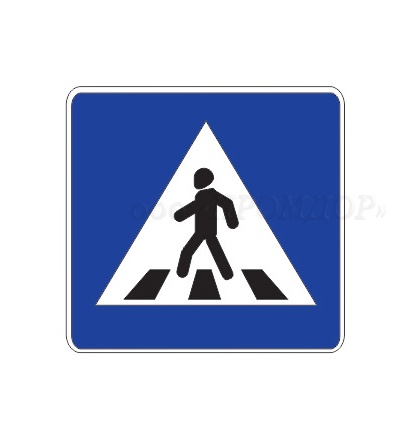 March 19, 2013 Administrator Home page » Road signs Views:
March 19, 2013 Administrator Home page » Road signs Views:
The “Pedestrian Crossing” road sign notifies the driver that he is starting to move along a very small and short, but extremely important section of the road.
Also, a dangerous area. After all, according to the traffic rules, a pedestrian crossing is a section on the roadway that is specially designated so that pedestrians can cross the road along it.
The road sign “Pedestrian crossing” is intended to designate this area.
The Pedestrian Crossing sign is presented in two main versions. On one of them (5.19.1) the pedestrian moves from right to left, and on the other (5.19.2) - from left to right.
This difference is used when directly installing signs on the road: option 5.19.1 is installed on the right side of the roadway before the crossing, and 5.19.2 is installed on its left side after the crossing (including on the dividing strip, if any).
Thanks to such installation of signs, the pedestrian crossing takes on visible outlines, and drivers are quite well informed about the location of the crossing and the direction of movement of pedestrians along it.
A very important issue is to understand the width of the pedestrian crossing, which is determined by horizontal road markings 1.14 (“zebra crossing”). In other words, the width of the zebra is the width of the transition.
In the absence of markings, as well as the difficulty or impossibility of perceiving them (for example, in winter), the width of the pedestrian crossing is calculated by the distance between the “Pedestrian crossing” signs located on both sides of the roadway.
The driver is obliged to strictly comply with the requirements prescribed by the “Pedestrian Crossing” sign. The main one is the need to let pedestrians who are at the crossing (crossing the roadway or stepping on it to cross) pass.
That is why the driver, when approaching a crossing, should do everything necessary to implement this requirement: for example, reduce speed or even stop to let pedestrians pass.
We will talk about this in more detail in the comments to Section 14 of the Traffic Rules. Here we will only indicate the driver’s responsibility to let pedestrians pass at a pedestrian crossing.
In addition, the driver must remember that certain traffic modes associated with the passage of pedestrian crossings are prohibited. So, in particular, at a pedestrian crossing the driver is prohibited from:
- Perform U-turns and reverse movements;
- Overtake (if there are pedestrians at the crossing);
- Stop and park (and also at a distance closer than 5 meters to the crossing).
These are the most serious requirements that are imposed on the driver when driving along a pedestrian crossing. That is why any driver must clearly know and strictly follow the rules for driving through these very dangerous sections of the road.
The driver must remember that a pedestrian is the most vulnerable road user. And hitting him within a pedestrian crossing is one of the grossest violations of the Traffic Rules.
And one last thing. The driver must be prepared for the fact that, even if a pedestrian jumped onto a pedestrian crossing in gross violation of the Rules (i.e. without making sure of safety and without assessing the distance to the approaching vehicle), it will be very difficult to prove his guilt.
Therefore, it will always be more rational and expedient for the driver to prevent a collision with a pedestrian than to later prove his innocence.
If this information was useful to you, please write about it in the comments. If you have any questions, write, I will definitely try to help you.
Traffic regulations online from the autoass team!
Source: http://autoass.ru/dorozhnye-znaki/5-19-1-peshexodnyj-perexod.html
Sign "Pedestrian crossing" according to traffic rules
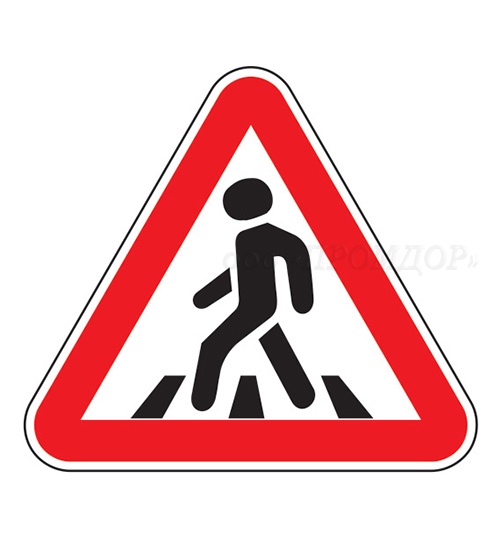
A pedestrian crossing is a special area of the roadway that allows pedestrians to cross the road comfortably and safely. According to traffic regulations, pedestrian crossings are marked with markings and supplemented with special signs.
Only signs can be used. Drivers in pedestrian crossing areas are subject to restrictions and rules, which often change.
You can find out about the current rules related to zebra crossings in this article.
Transition sign
Pedestrian crossings exist in several varieties: above-ground, above-ground and underground.
The usual “zebra crossings” on the roadway are called ground crossings. There are two subspecies:
- There is no adjustment (no traffic lights). Used in areas with little traffic. The sign used for designation is 5.19. Sometimes it is supplemented by a warning traffic light with a flashing signal.
- With regulation (traffic light). It is used on roads with busy traffic where there is a danger for pedestrians. Sometimes traffic lights are equipped with a button.
In addition to the listed designations, since 2010 road workers have been required to mark out additional crossings. This is a whole list of means, however, their use is justified by increased safety:
- Signs must have light animation and be outlined in yellow.
- The gaps between the white stripes on the asphalt are filled with orange paint.
- It is planned to install several speed bumps.
- Yellow flashing lights warning of the crossing are also required.
- At night, the zebra crossing should be sufficiently illuminated.
Underground and overground crossings are considered off-street; their installation and maintenance are accompanied by large financial costs, which is why they are placed on road sections with heavy traffic flow.
The rules of the sign are as follows:
- At unregulated crossings, in accordance with clause 14.1 of the Russian Traffic Regulations, drivers must give way to pedestrians crossing a zebra crossing.
- If there is a traffic light, the driver also needs to be vigilant and give way to those pedestrians who did not manage to complete the crossing of the roadway. The situations are described in detail in the traffic regulations, clause 13.1.
The sign's coverage area is as follows:
- The sign exists in two varieties, differing in the direction of movement of the pedestrian figure - to the right or to the left. There are no differences in traffic rules between the signs. The area where pedestrians cross the road is limited by a zebra crossing; crossing beyond it within the range of the sign is already considered a violation. If there is a crossing marking, the sign will be valid within its boundaries.
- You can park or stop your vehicle at a distance of at least five meters from the zebra on both sides.
Overhead passage
Overpasses are structurally bridges over the roadway or railway tracks. They are equipped with rainproof roofing and often elevators for people with limited mobility.
Overground corridors have a number of advantages:
- high security;
- lower cost compared to underground passages;
- no need for constant lighting
Indicated by sign 6.7. Despite this, overpasses require serious engineering research, precise calculations during construction and quite serious material costs.
Underground crossing
Underpasses are tunnels located under roads. They are equipped with steps and ramps to create conditions for all categories of pedestrians.
Next to the tunnel itself there is a sign 6.6 - “underground passage”. The first underground passage in Moscow was built in 1959. Today, these structures relieve road congestion in many cities across the country.
Violations when passing pedestrian crossings
One of the security vulnerabilities of Russian roads is pedestrian crossings. Due to the increase in the number of violations, in 2013 it was decided to toughen the punishment for neglecting traffic rules.
For violating the rule, the driver will face a fine of 1.5 thousand rubles or more in accordance with Article 12.18 of the Administrative Code.
A more serious fine is imposed for violating the rules of passage of a controlled crossing. Simply put, for pedestrians using the green lane. This punishment for this violation is regulated by Art. 12.12 part 1 of the Code of Administrative Offenses and amounts to 1000 rubles. However, we are talking only about the primary recovery.
If the driver is repeatedly caught ignoring the rules, his driver’s license is subject to confiscation for a period of 4-6 months. plus payment of a fine of up to 5 thousand rubles.
Pedestrians will also be fined if they violate the rules for crossing the road. According to the Administrative Code, a fine of up to 500 rubles can be collected.
Video about the action of the sign
The number of signs and crossing crossings is only increasing every year. They help the driver to brake in advance and allow pedestrians to pass. The punishment for violating traffic rules is now not just unpleasant, but very severe. Therefore, it is best to try not to break the rules, both for motorists and pedestrians.
Source: http://ru-act.com/avtoyurist/znak-peshexodnyj-perexod-po-pdd.html
Road sign "Pedestrian crossing"
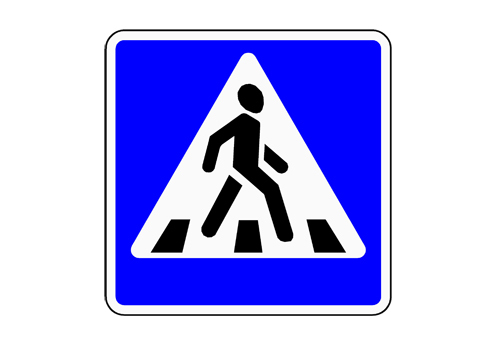
The roadway includes not only space for cars to move, but also areas where people walk to the other side of the street. Crossing is a special area for crossing to the other side of the street along the roadway area.
It ensures the safe crossing of the roadway for people. For reference, such territories are marked with special signs and markings.
Pedestrian crossing sign - indicates the immediate place where a motorist must let a person pass to cross to the other side of the street. Breaking a rule results in punishment.
general information
The rules provide two symbols indicating a ground crossing. One depicts a man walking to the right, the second - to the left. They are located on both sides of the road surface, facing the driver. The coverage area of a pedestrian crossing is determined by the length between the signs . How a pedestrian crossing is designated is approved by the rules and looks like this:
sign 5.19.1 sign 5.19.2
Regular crossings are additionally marked with a zebra crossing on the road surface.
Rules for installing signs are reflected in special GOSTs. When there is no special marking, sign 5.19.1 is located to the right of the roadway, and the second sign 5.19.2 is located to the left of the roadway at the end of the pedestrian crossing area.
Responsibility
Now the penalties for violating the rules on the roads have become tougher. Based on the Administrative Code, the fine is expressed in the amount of 1.5 thousand rubles.
The penalty may be more severe if the offense is committed a second time at a controlled intersection . If such circumstances exist, the fine will be 5 thousand rubles . or deprivation of a driver's license, which is the most severe measure of influence on the driver under such circumstances.
A pedestrian will also not go unpunished if he violates the rules of conduct on the roads. He may be held liable in the form of a fine of 500 rubles. The traffic police inspector has the right to punish him if an offense is actually detected.
Overpass pedestrian crossing sign
In large cities, off-street corridors or overpasses are additionally installed. Such structures are presented in the form of bridges over the road surface and are necessary for the movement of people. They are installed over a wide roadway or over railway tracks. They are indicated on both sides by special signs. The picture of the sign is as follows:
Overpasses are necessary for motorists to avoid additional traffic jams. Their purpose is also related to ensuring the safety of people. This sign is included in the category of signs to inform all road users. It does not entail prohibitory actions.
Underpass sign
Source: http://cabinet-lawyer.ru/avtopravo/znak-peshekhodnyy-perekhod.html
Pedestrian crossing sign – coverage area, what it looks like, where it can be found, what rule it reflects
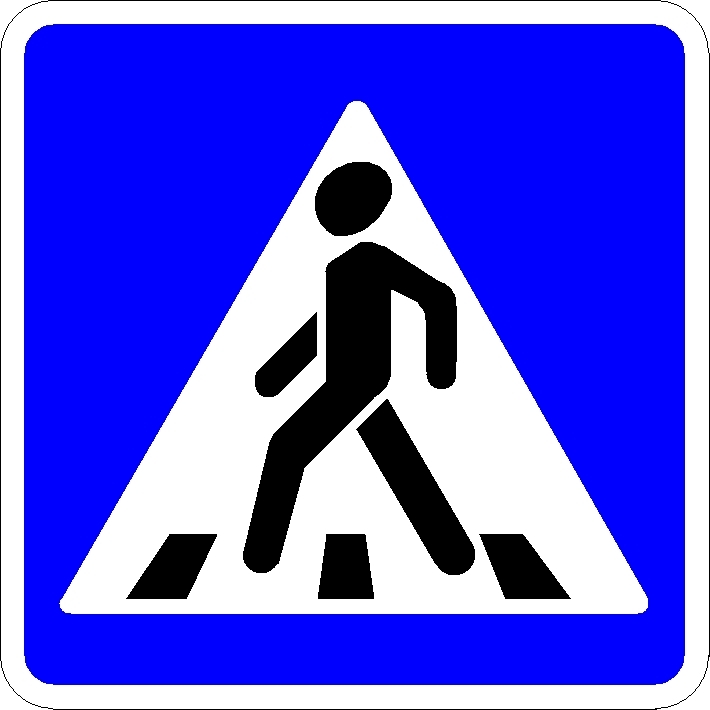
In order to regulate traffic on highways, special signs are used. They are designed for all drivers and pedestrians. A pedestrian crossing sign is provided to allow pedestrians to cross the road.
This is the most familiar sign among all pedestrians and drivers among other road signs. It creates conditions for the safe movement of people across any roads.
All drivers are required to stop and let pedestrians pass if there is one.
Note!
* Due to frequent changes in legislation, information sometimes becomes outdated faster than we can update it on the site.
* All cases are very individual and depend on many factors. Basic information does not guarantee a solution to your specific problems.
That's why FREE expert consultants work for you around the clock!
Pedestrian crossing sign: what it looks like and types
Pedestrian crossings come in several varieties. Their choice is usually determined by the characteristics of the area. This is also affected by the interchanges of existing roads. Transitions can be divided into the following types:
- ground;
- underground;
- overhead in the form of bridges.
The most common are ground-type pedestrian crossings. They have signs and markings on the road surface itself, and can be regulated or unregulated.
A pedestrian crossing is marked with markings and signs immediately or separately. At crossings not regulated by traffic lights, 5.19.1 is used. Road sign 5.19.2 may also be installed.
The difference between signs 5.19.1 and 5.19.2 is only in the direction of movement
In the first case, the transition will have a left direction, and in the second case it will be directed to the right.
Large highways with heavy vehicle traffic and multiple lanes are equipped with elevated pedestrian devices . They look like bridges over the roadway.
These rather narrow structures are suitable only for the movement of people. In this case, pedestrians will not have to go to the part where cars are moving when crossing the road. This in itself eliminates the possibility of any accidents.
All overpasses are equipped with a special sign 6.7.
Typically, such crossings are placed above railway tracks. In this case, they are equipped with exits to the platforms where trains arrive
This image represents a man walking up the stairs. But the disadvantage of such pedestrian crossings is their bulky design. Also, when arranging such crossings, it is important to have free space at the edges of the road.
In large cities, the most popular among pedestrians are underground passages, since they do not involve access to the roadway. This ensures the safe movement of people even across busy highways. In passages that are underground, a sign numbered 6.6 is installed.
Such crossings can also be found at metro descent points.
It shows a man walking down the stairs. Underground passages have many advantages, but their disadvantage is the rather high cost of construction. At the same time, an overpass for pedestrian traffic will be much cheaper in terms of costs.
Which rule reflects
The driver is obliged to give way to a pedestrian crossing the road at a marked crossing
When driving a car through a ground-type pedestrian crossing, each driver must strictly adhere to traffic rules. Moreover, this requirement applies to all vehicles without exception.
The sign indicates to drivers that they are starting to move along an important section of the road. People move around in this part of the roadway.
This sign requires all drivers to give way to pedestrians crossing the street. At the same time, the presence of a pedestrian crossing gives each pedestrian some advantage over a car.
When approaching a crossing, the driver of any vehicle must stop or significantly reduce speed. Thus, it provides the opportunity for all pedestrians to safely cross the roadway.
Traffic rules at pedestrian crossings prohibit the following actions by drivers:
- perform any types of turns;
- move in reverse;
- overtake if there are people at the crossing;
- park directly at the crossing;
- cross a zebra crossing;
- park in the area covered by 5.19.
Sign's coverage area and where it is installed
Zebra allows you to attract even more attention to the pedestrian crossing
Pedestrian crossings regulated by signs 5.19.1 and 5.19.2 can often be found on city streets. Between them, perpendicular to the main movement, a special marking is applied, which consists of alternating white and yellow stripes. This marking is called “zebra”. It allows you to attract the attention of drivers and pedestrians.
If the road simply has two signs 5.19.1 on two sides of the road, then the length of the transition is the distance from one to the other.
Features of parking and parking, fines for violation
You must park your car at a certain distance from the pedestrian crossing, which cannot be more than 5 meters.
An exception to this rule can be considered an accident or car breakdown. Thus, parking a car is only allowed behind it.
The distance of 5 meters must be considered from the road sign to the car or, in the absence of such a sign, from the zebra marked on the road surface.
Also, when parking near crossings, you must observe the following rule: there must be a distance from the car to the intersection, which is no more than 5 meters.
For violating parking rules, the law imposes a fine on the driver, which amounts to one thousand rubles. If there is no driver in the car, it will be evacuated to the traffic police parking lot. In this case, the driver will have to pay a fine of one thousand rubles for transportation by tow truck and parking.
If the established traffic rules are violated at a pedestrian crossing, the driver will be stopped by a traffic police inspector. He will be required by law to draw up a protocol on the existing violation and impose a fairly large administrative fine. And such a measure is completely justified and understandable.
As a result of non-compliance with the rules of passage at the crossing, adults and children may suffer. For violating the passage of a pedestrian at a pedestrian crossing, the fine can be 1.5 thousand. For crossing a red light - up to a thousand rubles.
Any driver should have a good understanding of how to properly drive on the most dangerous sections of the road. In addition, he must comply with the rules for passing pedestrian crossings. Every pedestrian is a participant in road traffic who can suffer the most. The most serious traffic violation is hitting pedestrians.
Source: https://avtopravo.guru/znaki/znak-peshehodnyiy-perehod.html
How to correctly understand the road sign “Pedestrian crossing”
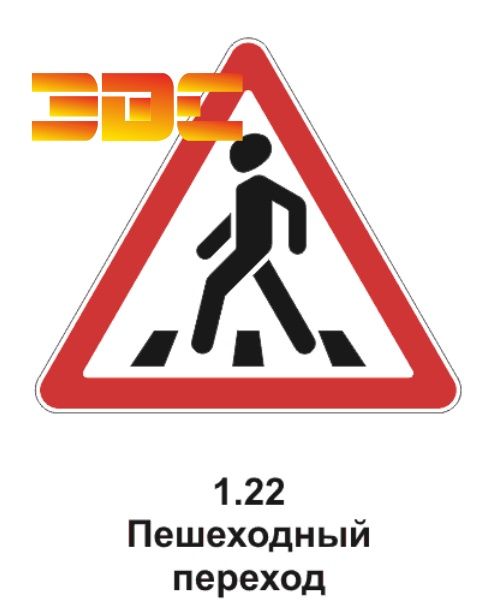
Types of symbols indicating a road for pedestrians , a “zebra”:
- Sign "Pedestrian crossing", "Children" . There is a symbol 1.23, which is a triangle bordered in red, on a white background of which two running figures of people are depicted. Drivers should not only prepare for the appearance of a child on the roadway, but also be sure to let him through if he has already stepped onto the zebra crossing. Maybe on the road and alone, he warns that you should slow down on this section of the road.
- Next to 1.23 there should be a designation 8.2.1, establishing the length of the section where it is valid. If this zone does not have a zebra crossing and a symbol informing about it, it is not intended for pedestrians. The child has no advantage. If a collision occurs, the driver is not considered guilty provided that he was moving at the permitted speed and did not violate other rules.
- A warning sign “Pedestrian crossing” is placed if the path for people to follow along the roadway is located directly on its surface. In traffic rules number 1.22, it looks like a white triangle with a red border, which depicts the figure of a man walking along a zebra crossing. It is not placed directly next to the zebra crossing. For it there are auxiliary designations 5.19.1 or 5.19.2. The first is a blue square with a white triangle inside, with a person walking to the left depicted inside. On 5.19.2 it goes to the right, but otherwise the symbol looks like 5.19.1. Both of these can be replaced by markup 1.14.1 and 1.14.2.
- The “Pedestrian crossing” road sign for an overpass is installed where the crossing device is in the form of a bridge. Designated by number 6.7. This is a blue square, inside of which a man is depicted walking up the steps in white. Not everyone knows that if it is present, crossing the road in this place on the roadway is prohibited.
- For an underground passage (lit tunnel underground) the traffic rules are numbered 6.6. The sign is similar to 6.7. But the man depicted on it is going down the steps. If there is an underground device, the pedestrian also does not have the right to cross the road on the plane where cars are driving.
- The “Pedestrian crossing is prohibited” sign is number 3.10. It is a white circle with a wide red border, which depicts a person crossed out with the same line. The exact name is “Pedestrian traffic is prohibited.” This symbol only works at the end of the road where it is located. If there is basically no path for pedestrians on the site, 3.10 is installed on both sides of it.
How and where the symbol will be located depends on its type:
- 6.6 and 6.7 are placed at the entrance and exit of underground and above-ground structures;
- for 1.22, the legal place is 50-100 m before the zebra crossing in a populated area and 150-300 m before it outside the city or village;
- 5.19.1 and 5.19.2 are located directly next to the transition;
- 1.23 should be located no closer than 50-100 m before the child care facility in the city, 150-300 m outside it (and also be duplicated after 50 m).
The size of the “Pedestrian Crossing” sign is chosen so that the distance does not interfere with seeing and identifying it. Parameters may vary depending on the type: 1st – 700 mm; 2nd – 900 mm; 3rd – 1200 mm. For 5.19.1 and 5.19.2, the same standard sizes are 600, 700 and 900 mm, respectively.
Read more in our article about all pedestrian crossing road signs, distances and driving rules.
Types of symbols indicating the road for pedestrians
There are several types of markings related to zebra crossings. Each is installed depending on where exactly and how the safety island is located for people crossing the road. What the “Pedestrian Crossing” signs have in common is that despite their external differences, they require compliance with the same rules.
Sign "Pedestrian crossing", "Children"
Young pedestrians often cross the road in places unsuitable for this. To protect children from the worst, responsibility for their safety falls partly on motorists. There is a symbol 1.
23, meaning that in its coverage area there is a high probability of a child suddenly appearing on the roadway. It is a triangle bordered in red, on a white background of which two running figures of people are depicted.
What are the features of 1.23:
- Drivers should be attentive if they see a combination of signs “Pedestrian crossing” and “Children”.
In this case, they must not only prepare for the appearance of a child on the roadway, but also be sure to let him through if he has already stepped onto the zebra crossing.
- He may be on the road and alone. 1.23 warns the driver that it is worth slowing down on this section of the route. The sign is placed near schools, kindergartens, and other institutions intended for young road users.
- Next to 1.23 there should be a designation 8.2.1, establishing the length of the section where it is valid. If this zone does not have a zebra crossing and a symbol informing about it, it is not intended for pedestrians. And a child crossing the road under the “Children” picture has no advantage. If a collision occurs, the driver is not considered guilty provided that he was moving at the permitted speed and did not violate other rules.
We recommend reading about the fine for driving at an intersection. From the article you will learn about penalties for driving into the oncoming lane at an intersection, into a busy intersection, or into a stop line.
And here is more information about the fine for not letting a pedestrian pass.
For ground
A warning sign “Pedestrian crossing” is placed if the path for people to follow along the roadway is located directly on its surface. In traffic regulations it has number 1.
22, looks like a white triangle with a red border, which depicts the figure of a man walking along a zebra crossing. The symbol informs the driver in advance that a pedestrian area will soon appear on his route.
It is not placed directly next to the zebra crossing.
For it there are auxiliary designations 5.19.1 or 5.19.2. The first is a blue square with a white triangle in it. And inside there is a picture of a man walking to the left. On 5.19.2 it goes to the right, but otherwise the symbol looks like 5.19.1. Both of these can be replaced by markup 1.14.1 and 1.14.2.
For overhead
The “Pedestrian Crossing” road sign is also installed where the device by which people cross the roadway is located above it in the form of a bridge. A person does not step on its surface itself.
And although the meaning of the existence of an overhead structure is still the same as a regular one, drivers will recognize its approach by symbol 6.7.
This is a blue square, inside of which a man is depicted walking up the steps in white.
Aboveground devices are relatively new. Therefore, not everyone knows that if it is present, crossing the road in this place on the roadway is prohibited.
For underground
If the transition is made in the form of an illuminated underground tunnel, its designation in the traffic rules is numbered 6.6. The sign is similar to 6.7. But the man depicted on it is going down the steps.
If there is an underground device, the pedestrian also does not have the right to cross the road on the plane where cars are driving. This is a life-threatening violation of the rules.
Sign "Pedestrian crossing prohibited"
In addition to the symbols that establish safety zones for people to cross the roadway, there are also those that do not allow this. The sign dictating that pedestrian crossing is prohibited is numbered 3.10 according to traffic regulations. It is a white circle with a wide red border, which depicts a person crossed out with the same line. The exact name is “Pedestrian traffic is prohibited.”
The symbol is installed in places where a person walking across the road would be difficult to see by drivers. Or where cars travel at high speeds, such as on highways, bridges, and one-way intersections.
This symbol only works at the end of the road where it is located. If there is basically no path for pedestrians on the site, 3.10 is installed on both sides of it.
What is the difference between installing a “Pedestrian crossing” sign?
How and where the symbol will be located depends on its type:
- if we are talking about 6.6 and 6.7, they are placed at the entrance and exit from underground and above-ground structures;
- for 1.22, the legal place is 50-100 m before the zebra crossing in a populated area and 150-300 m before it outside the city or village;
- 5.19.1 and 5.19.2 are located directly next to the transition;
- 1.23 should be located no closer than 50-100 m before the child care facility in the city, 150-300 m outside it (and also be duplicated after 50 m).
The size of the “Pedestrian Crossing” sign is chosen so that the distance does not interfere with seeing and identifying it. Parameters may vary depending on the type:
- 1st – 700 mm;
- 2nd – 900 mm;
- 3rd – 1200 mm.
For 5.19.1 and 5.19.2, the same standard sizes are 600, 700 and 900 mm, respectively.
The installation of a “Pedestrian Crossing” sign is subject to a number of conditions:
- the area should be well lit;
- it is located in a clearly visible area;
- if we are talking about a ground zebra crossing, there must be speed bumps on both sides of it;
- marking lines are made alternating in white and yellow colors;
- the symbol is framed in a glow-in-the-dark yellow frame, and a flashing light device of the same color may be installed next to it.
Effective area of the Pedestrian Crossing sign
It is easier to understand where exactly it is allowed to cross the road if you are dealing with above-ground or underground structures. The bridge and tunnel are areas for crossing the roadway. But not the plane of the road under and above the devices along which cars move.
It is more difficult if we are talking about a ground zebra crossing. The following traffic regulations will help determine where the zone of coverage of the “Pedestrian Crossing” sign is located:
Pedestrian crossing is a section of the roadway marked with signs 5.19.1, 5.19.2 and (or) markings 1.14.1 and 1.14.2 and allocated for the movement of pedestrians across the road. In the absence of markings, the width of the pedestrian crossing is determined by the distance between signs 5.19.1 and 5.19.2.
That is, if there are these symbols without lines 1.14.1 and 1.14.2 on the road, you should navigate by them. If there is a zebra crossing, the width of its stripes is the transition. You cannot go beyond the limits, even if there are signs nearby.
Otherwise with warning symbol 1.22. Its coverage area is the same 50-100 or 150-300 m. But this does not mean that this is the area on which pedestrians can walk. 1.22 exists for drivers who, already at this distance, must slow down and be more careful.
Pedestrian crossing sign rules
The presence of a zebra crossing means compliance with special conditions, primarily by motorists. The main rule of a pedestrian crossing sign is that a person has priority over a car if there is no traffic light. In the regulated area, you should focus on the signals of the light device.
For drivers, regardless of the type of crossing, there are other rules:
- U-turn prohibited;
- you cannot overtake;
- It is unacceptable to park at a distance of up to 5 m from it;
- cyclists and scooter riders must cross the zebra crossing on foot, driving their vehicles nearby.
Pedestrians are prohibited from crossing the road where there is a sign 3.10. If the offender managed to avoid being hit by a car or survive after it, he will be punished for violating traffic rules.
Sign colors
The symbols installed to designate pedestrian zones on the roadway are externally different. And small changes in the requirements for them can confuse traffic participants. In fact, everything is not so scary:
- The yellow “Pedestrian Crossing” sign is made so that the paint stands out brighter in headlights at night. The frame can be seen especially often on roads outside the city.
- Blue symbols (5.19.1 and 5.19.2) are usually placed in populated areas, where they are easy to notice. They limit the space through which a person can cross the roadway.
- A red pedestrian crossing sign warns the driver that it is time for him to slow down. After all, he is about to see a “zebra” or symbols 5.19.1 and 5.19.2.
We recommend reading about accidents involving pedestrians. From the article you will learn about liability for an accident at a pedestrian crossing due to the fault of the driver/the fault of the pedestrian, and how an examination will help to understand the case.
And here is more information about accidents with cyclists.
Crossing signs are a guarantee of safety for pedestrians and drivers. Neither one nor the other should ignore them while driving. Otherwise, it may end not only with a fine, but with injuries and a criminal case.
Source: https://avto-urist.online/dorozhnyj-znak-peshehodnyj-perehod/
Road sign “Pedestrian crossing” and everything a motorist needs to know about it
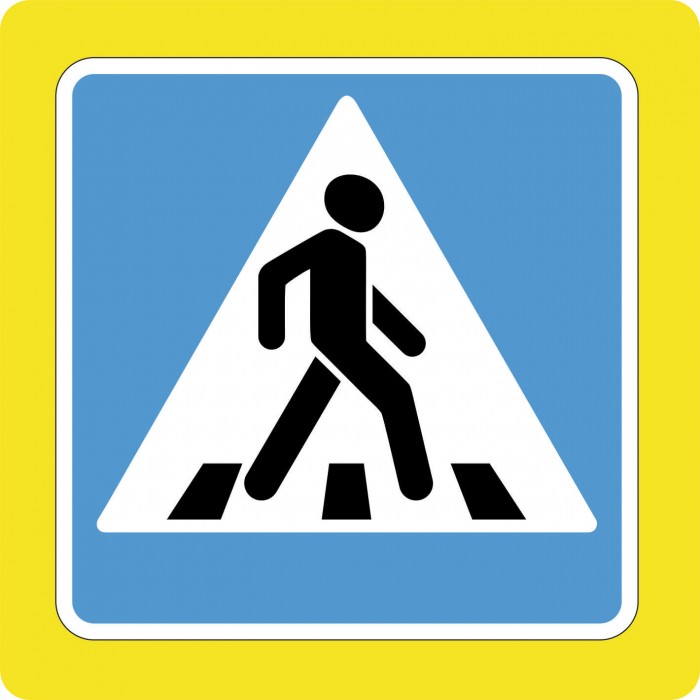
Road users are not only drivers, motorcyclists and cyclists, but also people who do not use any transport for their movement. Such traffic participants are called pedestrians and are also subject to the rules prescribed in the traffic rules.
Many roads include sidewalks for pedestrian movement. They are separated from the roadway by a curb and do not allow vehicles to travel on them.
And in order for pedestrians to cross from one side of the street to the other, there are special road sections for them - pedestrian crossings.
When a person moves along such a segment, the driver must give way to him. So that drivers can recognize areas for pedestrian traffic participants, a “Pedestrian Crossing” traffic sign is installed next to them.
Discounts on new cars! Advantageous loan from 9.9%
Installment plan 0%
There are several types of such pointers. The specific type of road marker is determined by the location of its installation and the method of crossing the roadway.
Pedestrian crossing sign 5.19.1
Appearance of the sign
The index belongs to the category of special instructions. It has a square shape. Its background is blue. There is a white triangle in the middle, base down. It depicts a black walking man. Moreover, he walks along black stripes.
Additionally
A traffic light may be located above such a sign. This means that the walking distance is adjustable. Both drivers and pedestrians must obey the requirements of light signals.
If the traffic light is not working, it means that the driver must give way to a pedestrian who is about to cross from one side of the street to the other.
A light signaling device can also be installed along with the tag. It is usually yellow in color. Such lamps are installed in places with high accident rates and heavy traffic. They are needed in order to attract the driver’s attention to the fact of the presence of an unregulated pedestrian path.
Coverage area
The “Pedestrian Crossing” sign is installed at the beginning of the zone for the movement of pedestrians and at its end. Such signs are located on different parts of the street. The coverage area of the “Pedestrian Crossing” sign is determined by the distance between them.
It is much easier to determine the length of such a segment if there is a zebra crossing. This is a series of white lines painted on the asphalt. Its width determines the width of the pedestrian road.
Rules of conduct for drivers
Now it’s time to talk about what actions the installed “Pedestrian Crossing” road sign obliges the driver to take.
If a pedestrian road appears in your visibility range, the sign warns you to slow down a little in order to be able to brake in the event that a person suddenly appears on the roadway.
However, the driver makes the decision to slow down independently. But there are requirements that cannot be violated. Otherwise, you may pay a fine.
- You cannot park on a zebra crossing or closer than five meters in front of it. However, the rules do not say anything about prohibiting parking of cars behind the pedestrian section. Therefore, you can stop the car immediately behind the pedestrian path.
- Overtaking is prohibited on a pedestrian area. There are many known cases when a driver, overtaking a passing car that had stopped at a zebra crossing, hit a pedestrian. To overtake, it is better to wait until the end of the section for pedestrians.
Similar signs
There are also road signs that are similar to plate 5.19.1 not only in appearance, but also in meaning. They should also be mentioned.
Transition coming soon
Outside populated areas or in particularly dangerous areas, you may come across a sign indicating that you are approaching a crossing.
This plate is numbered 1.22. It is triangular in shape. The edges are framed with a red stripe. Inside there is a black man already familiar to us, walking along a striped road.
Such markers are installed 50–100 meters before the zebra crossing. They must force the driver to be extremely careful to avoid hitting a pedestrian.
Underground crossing
For the safety of pedestrian traffic participants, not only zebra crossings are being created, but also more thorough street crossing points. One of them is an underground passage.
The presence of such a tunnel obliges pedestrians to go underground and cross the road. The presence of such a sign does not oblige the driver to do anything. However, he warns that there may be people on the road.
The fact is that not all citizens are happy about the opportunity to cross the street in conditions of maximum safety. People with disabilities, pensioners, and simply lazy pedestrians every now and then strive to cross the road on top, rather than going underground to do so.
The driver must be prepared for this.
The underground passage sign is informational and has the number 6.6. It is square in shape. The background of the image is blue. It depicts a white man walking down the steps of a staircase.
Overhead passage
There is another type of safe crossing - overground. It looks like a viaduct located above the roadway.
This label, like the previous one, is purely informational. It has the number 6.6 and is very similar to the designation “subway”. Only in this case the little man does not go down the stairs, but goes up it.
Street for pedestrian traffic
There are also streets on which car traffic is completely prohibited. Such streets are marked with a special “Pedestrian Road” sign.
It is round and blue. It depicts a walking white man. The presence of this sign tells the driver that it is not permissible to enter this street.
Finally, let us remind you that in any case of a car hitting a pedestrian, the driver is considered to be at fault. Therefore, when driving a car, you need to be guided not only by the instructions of the signs, but also by common sense.
Be attentive and tolerant of other road users.
Source: http://CarExtra.ru/obuchenie/znak-peshehodnyiy-perehod.html


